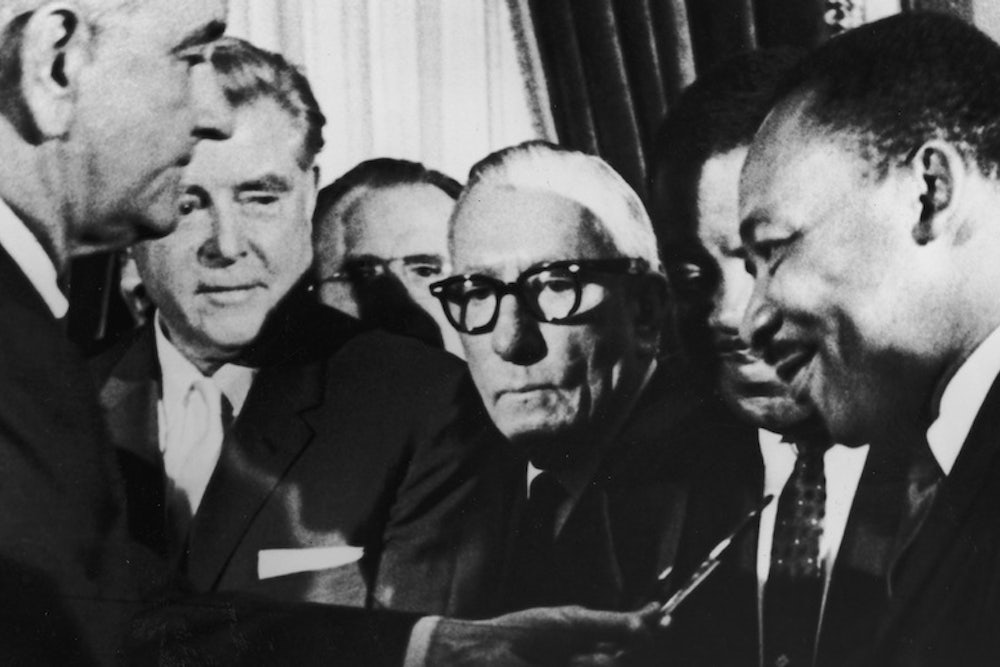The Civil Rights Act was the most important legal step to combat inequality taken in the United States since the three Reconstruction amendments were added to the Constitution in the 1860s. The Bill of the Century is the title of Clay Risen’s smart and stirring new history of the struggle to pass it, and one can’t really argue with that.
Yet the law’s significance lies as much in the battles that were waged over whether and how to enforce it as in the ways it changed American society for the better. In 1964, James J. Kilpatrick, a popular syndicated columnist, declared in National Review, “This precious right to discriminate underlies our entire political and economic system” and warned of perils to come. Fierce opposition to implementing the CRA was largely responsible for Lester Maddox’s election as governor of Georgia in 1966 and for George Wallace’s capture of 46 electoral votes two years later. Meanwhile, millions of whites from Southern and border states moved away from cities lest they and their children have to share public spaces and schools with black people.
All over the country, flashpoints emerged over Title VII of the Act, which prohibits employers from discriminating against employees based on race, religion, sex, or national origin. Right after the law was passed, as Nancy MacLean describes in her indispensable book, Freedom Is Not Enough, workers of different races and both genders began putting it to the test. Grievances from black painters, Mexican-American postal workers, and white airline stewardesses flooded into the offices of the new Equal Employment Opportunity Commission (EEOC), which the 1964 Act had created. During the EEOC’s first year, women lodged more complaints related the “loss of jobs due to marriage or pregnancy” than to any other issue related to sex discrimination (as it was then called). The National Organization for Women, founded in 1966, first made a name for itself when it petitioned the EEOC to ban want ads segregated by gender.
Title VII also enabled federal courts and politicians to claim that “affirmative action”—a term JFK first used in a March 1961 speech—was needed to redress historic inequalities. Anxiety over quotas, set-asides, and preferences burned through the rest of the twentieth century, fueling the triumphs of conservatives like Ronald Reagan and Jesse Helms, who maintained they were just forms of “reverse discrimination.” Nevertheless, affirmative action gradually opened up jobs in the professions and better-paid crafts to individuals from “protected groups” who seldom had been able to gain them before.
The legitimacy of the 1964 statute also catalyzed a “rights revolution” that continues to inspire millions of Americans and infuriate others. Other minority groups besides African Americans began to claim their right to jobs and cultural respect in language borrowed both from the CRA and from the black power movement, which emerged later in the decade. Few people would now object, at least publicly, to the greater access and job opportunities now enjoyed by disabled men and women thanks to the Americans with Disabilities Act (1990), which is modeled on the CRA. But that is hardly the case for homosexuals and recent immigrants, who don’t draw the universal sympathy accorded to people who need wheelchairs or guide dogs to get around. And the notion of health care as a “civil right,” first popularized by left-wing medical activists and Senator Edward Kennedy in the 1960s and ’70s, was frequently invoked by backers of the Affordable Care Act. Perhaps James Kilpatrick was not such an alarmist after all.
Yet 50 years later, no conservative with big political ambitions would dare argue for repeal of the Act that departed icons like Barry Goldwater and Ronald Reagan once publicly condemned. "You can't legislate morality,” remarked Goldwater, when he voted against the CRA in 1964. (Rand Paul did have the chutzpah to tell Rachel Maddow in 2010 that he would have voted against Title II—the equal accommodations section of the Act—because the federal government should not restrict the freedom of private businesses. He quickly corrected himself the next day.)
But that doesn’t mean that the work of the CRA is done. A number of recent academic studies have documented that Republicans are far more likely than Democrats to believe, as political scientists Michael Tesler of Brown University and David O. Sears of UCLA recently put it, “Irish, Italian, Jewish, and many other minorities overcame prejudice and worked their way up. Blacks should do the same without any special favors.” Fifty years ago, Kilpatrick urged white voters to rise in “resentment” against “those who demand in the name of race what they have not earned in the way of worth.” Some, it seems, are still rising.
At the end of his book, Risen writes that, whatever you think about the post-enactment history of the CRA, “one thing can be said with certainty: the act revolutionized American society by placing the federal government undeniably and forcefully on the side of African Americans.” Yet even with a black man in the White House, equal rights, in fact if not rhetoric, remains a difficult pursuit marked by incomplete triumphs and backward steps. The United States has remained a society that prizes the self-reliant, “free” individual and is wary of levellers who preach a politics of altruism. Thus, the vision embodied in “the bill of the [last] century” remains only partially fulfilled in this one.
Michael Kazin is a contributing editor of The New Republic and editor of Dissent. His latest book is American Dreamers: How the Left Changed a Nation.
